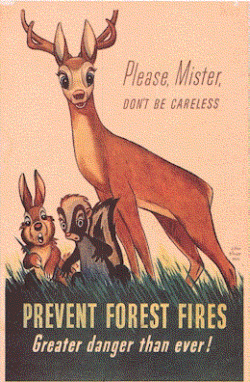 SKC Films Library |
| SKC Films Library >> Economics >> Advertising |
| Smokey Bear the official spokesman for the U.S. Forest Service's "Only You Can Prevent Forest Fires" campaign In the spring of 1942, a Japanese submarine fired a salvo of shells that exploded on an oil field near Santa Barbara, California, igniting a fire that briefly threatened to engulf nearly Los Padres National Forest. Fearing that another attack could actually spark a major forest fire and overwhelm the already strained home front forces, the Forest Service launched a major public service campaign aimed at preventing accidental forest fires. With help from the Wartime Advertising Council, the Forest Service created a series of posters featuring such slogans as "Careless Matches Aid the Axis," "Forest Fires Aid the Enemy," and "Our Carelessness, Their Secret Weapon." The campaign worked, and the Forest Service was saved from having to fight any major forest fires sparked by careless American citizens. World War II-era forest fire
prevention poster In 1944 Walt Disney released the animated movie Bambi, which included the heartbreaking scene in which Bambi's mother was killed in a forest fire. That one scene proved so memorable and moving that Disney allowed the Forest Service to use Bambi's image in its campaign for a year. The use of animals to emphasize the importance of forest fire prevention proved to be even popular than all of the previous campaigns combined, and the Forest Service decided it needed an animal to be the permanent symbol of its Forest Fire Prevention campaign, and the most successful public service advertising campaign in history was launched. forest fire prevention poster
featuring Bambi and Friends On August 9, 1944, the Forest Service released a poster showing a bear wearing blue jeans and a ranger hat pouring water on an unattended campfire. The caption read "Smokey Says -- Care will prevent 9 out of 10 forest fires!" The bear was named for "Smokey" Joe Martin, a former Assistant Chief of the New York City Fire Department. Smokey Bear has been the spokesman for the Forest Service's Forest Fire Prevention campaign ever since. the first Smokey Bear poster In the spring of 1950, a fire broke out in New Mexico's Lincoln National Forest. After fighting the fierce fire for several days, a group of firefighters came across a bear cub that had taken refuge from the fire by climbing a tree. Once it was determined that the cub's mother was nowhere to be found, the cub, whose paws and hind legs had been badly burned in the fire, was taken home by a rancher, who then turned him over to the New Mexico Department of Game and Fish for veterinary treatment. The plight of "Hotfoot Teddy," as he was nicknamed, quickly became front page news, and his recovery was watched by millions of concerned Americans. The New Mexico State Game Warden subsequently presented the cub to the Forest Service, with the understanding that he would be dedicated to the service's fire prevention and conservation campaign. Hotfoot Teddy being treated for his
burns Given his own special quarters at the National Zoo in Washington, D.C., the little cub who had taken refuge from a forest fire by climbing a tree suddenly found himself becoming the living symbol of Smokey Bear. Before long Smokey was receiving so much fan mail that the Postal Service had to assign him his own zip code. He remained a living symbol of forest fire prevention until retiring from public display in 1975. The real life Smokey died in 1976, and was buried in the same forest which had almost taken his life as a cub. Although another bear cub was chosen to take his place in public, Smokey II never quite captured the public's imagination as much as the original, and the live bear part of the Smokey Bear campaign was discontinued in 1990. In 1952, Congress passed an act taking Smokey Bear and his likeness out of the public domain and placing them under the control of the Secretary of Agriculture. That act requires all royalty and licensing fees to be used for forest fire prevention and forest conservation. Also in 1952, Steve Nelson and Jack Rollins wrote a song entitled "Smokey the Bear." The word the was added simply to maintain the rhythym of the song, however, and the official name of the "Only You Can Prevent Forest Firest" spokesman remains Smokey Bear. In 1984, Smokey Bear became the first individual animal to be honored on a U.S. Postage stamp. Official Website of Smokey Bear www.smokeybear.com Remember -- Only You Can Prevent
Forest Fires Smokey Bear postage stamp |
| SKC Films Library
>> Economics
>> Advertising This page was last updated on September 26, 2017. |





